 If you’ve never experienced a raspberry soufflé, it’s like tasting warm, fluffy, raspberry-flavored air. Sweet, light and ephemeral. And the good news is that this elegant dessert is remarkably easy to make. I’m not an expert on dessert soufflés, but when I saw Michel Guérard, one of France’s most venerated chefs, whip up a couple of small raspberry soufflés during a television feature, I knew I had to try to make them myself. Instant success!
If you’ve never experienced a raspberry soufflé, it’s like tasting warm, fluffy, raspberry-flavored air. Sweet, light and ephemeral. And the good news is that this elegant dessert is remarkably easy to make. I’m not an expert on dessert soufflés, but when I saw Michel Guérard, one of France’s most venerated chefs, whip up a couple of small raspberry soufflés during a television feature, I knew I had to try to make them myself. Instant success!
Soufflés aux framboises / Raspberry soufflés
Michel Guérard is one of the fathers of nouvelle cuisine, the lighter, fresher version of French cooking that became a sensation in the 1970s. He’s had three stars in the Michelin restaurant guide for more than 40 years, a rare distinction. He’s a genial man — in the France 2 broadcast, he held a freshly picked raspberry in his hand and said it felt like caressing a woman. Back at his kitchen, he showed viewers drawings he’d made in cocoa for Queen Elizabeth when she visited Versailles on her first trip to France.
But Michel Guérard was careful in the broadcast not to give away all of his secrets. For example, he didn’t say how much sugar to add to the soufflé batter and how much to use for coating the cups. I had to wing it. He also omitted to say how to make the sugar adhere to the cups. With butter? With egg white? I asked around — it’s butter.
Another thing. The soufflés go into the oven for just 4-5 minutes — so that the inside stays creamy, he said. I found that astoundingly brief, but guess what? The recipe works. I’ve made it three times now, to resounding applause. And it takes no more than 10 minutes to prepare. You purée the raspberries and push the purée through a sieve to remove the seeds, you add sugar and an egg yolk, you butter and sugar your soufflé cups, you beat three egg whites, you fold the whites and the raspberry mixture together and — here’s the master coup — when you pile the mixture into the cups you even it off with the edge of a spatula. In the oven, they pop up ever so nicely. And they are a treat to eat.
Happy cooking.

 It’s only May and it’s already summer in the city in Paris — a great time to enjoy grilled pork brochettes with tomato, cucumber and red onion, even if you don’t have a barbecue. Today’s recipe adds a French twist to a Russian summertime favorite, shashlik. The secret is marinating the pork in — wait for it — red wine vinegar. I couldn’t believe this when a Russian friend first gave me the recipe. In France we mainly marinate in wine. But it works.
It’s only May and it’s already summer in the city in Paris — a great time to enjoy grilled pork brochettes with tomato, cucumber and red onion, even if you don’t have a barbecue. Today’s recipe adds a French twist to a Russian summertime favorite, shashlik. The secret is marinating the pork in — wait for it — red wine vinegar. I couldn’t believe this when a Russian friend first gave me the recipe. In France we mainly marinate in wine. But it works.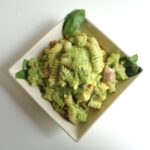 A culinary delight on a recent trip to Italy was an innovative pairing of twisty pasta and zucchini. This dish — the creation of my friend Gisella, a superlative cook — is not as simple as it sounds. The zucchini is cooked two ways so that the pasta is both bathed in a silky zucchini sauce and embellished with strips of sautéd zucchini. Grated parmesan, small squares of dry-cured ham and snipped fresh basil are added at the end.
A culinary delight on a recent trip to Italy was an innovative pairing of twisty pasta and zucchini. This dish — the creation of my friend Gisella, a superlative cook — is not as simple as it sounds. The zucchini is cooked two ways so that the pasta is both bathed in a silky zucchini sauce and embellished with strips of sautéd zucchini. Grated parmesan, small squares of dry-cured ham and snipped fresh basil are added at the end.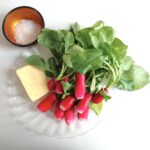 A quintessentially French dish that comes into its own in springtime is radis au beurre, or radishes with butter and salt. This traditional bistro fare makes a great start to a meal. I often serve radis au beurre at cocktail hour — fresher and much lighter than chips or nuts, especially if you go easy on the butter. Radis au beurre may also be served as a first course at the table, often accompanied by other back-to-the-land starters.
A quintessentially French dish that comes into its own in springtime is radis au beurre, or radishes with butter and salt. This traditional bistro fare makes a great start to a meal. I often serve radis au beurre at cocktail hour — fresher and much lighter than chips or nuts, especially if you go easy on the butter. Radis au beurre may also be served as a first course at the table, often accompanied by other back-to-the-land starters. One thing to note is that French radishes are rosy red with a white tip and elongated rather than round. They also tend to be less piquant than round varieties. (Strangely, they are referred to in English as ‘French breakfast radishes’, although I have never seen radishes served for breakfast over here.) No need to fret if you live elsewhere. Any red radishes would be fine for this dish.
One thing to note is that French radishes are rosy red with a white tip and elongated rather than round. They also tend to be less piquant than round varieties. (Strangely, they are referred to in English as ‘French breakfast radishes’, although I have never seen radishes served for breakfast over here.) No need to fret if you live elsewhere. Any red radishes would be fine for this dish. This dish of chicken in a creamy paprika sauce came about as a result of current events. I thought I’d like to make something Ukrainian in honor of a besieged nation, and I also wanted to add to the poultry dishes already on this site. My first idea, rather naturally, was chicken Kyiv (suprêmes de volaille à la Kyiv). But a little research showed that this dish, which by the way is quite complicated to make, is actually Russian in origin. Nyet.
This dish of chicken in a creamy paprika sauce came about as a result of current events. I thought I’d like to make something Ukrainian in honor of a besieged nation, and I also wanted to add to the poultry dishes already on this site. My first idea, rather naturally, was chicken Kyiv (suprêmes de volaille à la Kyiv). But a little research showed that this dish, which by the way is quite complicated to make, is actually Russian in origin. Nyet.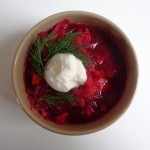 Grandma Anne was a good cook, although her imprecision with measurements drove my mother crazy. For example, her recipe for syrniki — little pancakes made with smooth cottage cheese and served with sour cream and jam — calls for ‘one half eggshell water’. I’d like to post this family recipe here one of these days, along with two more, Grandma Anne’s fabulous stuffed cabbages and her wonderful cheesecake.
Grandma Anne was a good cook, although her imprecision with measurements drove my mother crazy. For example, her recipe for syrniki — little pancakes made with smooth cottage cheese and served with sour cream and jam — calls for ‘one half eggshell water’. I’d like to post this family recipe here one of these days, along with two more, Grandma Anne’s fabulous stuffed cabbages and her wonderful cheesecake.  Meantime when thinking about today’s post I was surprised to realize that I’ve already posted two Ukrainian dishes on this site —
Meantime when thinking about today’s post I was surprised to realize that I’ve already posted two Ukrainian dishes on this site — 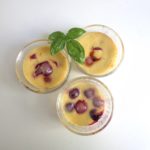 Happy cooking.
Happy cooking.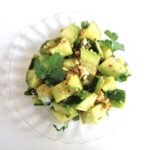 I discovered this spicy peanut-topped cucumber salad just as Sichuan cuisine began making it big in Paris. It’s on the menu of
I discovered this spicy peanut-topped cucumber salad just as Sichuan cuisine began making it big in Paris. It’s on the menu of 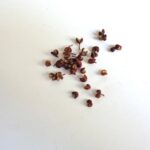 The key ingredient in this salad, as in many Sichuan recipes, is Sichuan peppercorn. It looks different from black peppercorn in that it’s a reddish brown and more wrinkled. Unlike hot red peppers (piments in French), Sichuan peppercorn is described as numbing rather than fiery. And its flavor is just unbeatable. You can find it at Asian grocery shops.
The key ingredient in this salad, as in many Sichuan recipes, is Sichuan peppercorn. It looks different from black peppercorn in that it’s a reddish brown and more wrinkled. Unlike hot red peppers (piments in French), Sichuan peppercorn is described as numbing rather than fiery. And its flavor is just unbeatable. You can find it at Asian grocery shops. The other day I decided to try to recreate a dish I vaguely remembered — cod with chickpeas, spinach and chorizo chips. It felt just right for a brisk, pre-spring sunny day. I checked my favorite Spanish cookbook, couldn’t find it. Ditto my Portuguese cookbook. Then I looked online, and found not a single recipe for this precise combination. So I winged it. Well, dear readers, my guest was happy. And in fact so was I.
The other day I decided to try to recreate a dish I vaguely remembered — cod with chickpeas, spinach and chorizo chips. It felt just right for a brisk, pre-spring sunny day. I checked my favorite Spanish cookbook, couldn’t find it. Ditto my Portuguese cookbook. Then I looked online, and found not a single recipe for this precise combination. So I winged it. Well, dear readers, my guest was happy. And in fact so was I. So whatever the origin of this particular dish, the flavors blend well. And, as I discovered, it is not just easy to make but has the significant advantage of being able to be prepared in advance. If you cook the chickpeas yourself — highly recommended — it’s best to start the evening before you plan to serve the dish. Tips on cooking chickpeas may be found
So whatever the origin of this particular dish, the flavors blend well. And, as I discovered, it is not just easy to make but has the significant advantage of being able to be prepared in advance. If you cook the chickpeas yourself — highly recommended — it’s best to start the evening before you plan to serve the dish. Tips on cooking chickpeas may be found  Flamiche is a savory tart from Picardie made of leeks and cream encased in puff pastry. This is comfort food at its finest, perfect for cool days or nights as we wait for spring. Flamiche can stand on its own as a lunch dish or may be served as a starter in the evening, accompanied by a fruity red. Its versatility makes it a winner. Yet this pie from Picardie is rarely encountered in other parts of France, not to mention the rest of the world.
Flamiche is a savory tart from Picardie made of leeks and cream encased in puff pastry. This is comfort food at its finest, perfect for cool days or nights as we wait for spring. Flamiche can stand on its own as a lunch dish or may be served as a starter in the evening, accompanied by a fruity red. Its versatility makes it a winner. Yet this pie from Picardie is rarely encountered in other parts of France, not to mention the rest of the world.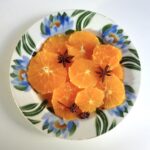 This light, refreshing dessert of orange slices in a flavorful syrup is best in winter, when large sweet oranges are in season. I first tasted it at the home of my neighbor Manuela, a superior cook. But on that occasion she barely cooked. The main course was a platter of oysters and langoustines straight from the market. She followed up with the sliced oranges, which were so delightful I had to have the recipe. The star ingredient was star anise.
This light, refreshing dessert of orange slices in a flavorful syrup is best in winter, when large sweet oranges are in season. I first tasted it at the home of my neighbor Manuela, a superior cook. But on that occasion she barely cooked. The main course was a platter of oysters and langoustines straight from the market. She followed up with the sliced oranges, which were so delightful I had to have the recipe. The star ingredient was star anise.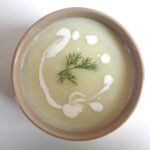 Hiding beneath its rather grand name, potage Parmentier is familiar to every child in France as potage poireaux-pommes de terre, or creamy leek-and-potato soup. It takes its name from Antoine Parmentier, who won royal approval of the potato (seriously!) on the eve of the revolution that toppled the kings of France. The soup — which unlike vichyssoise is served hot — makes a satisfying, and some would say elegant, winter dish.
Hiding beneath its rather grand name, potage Parmentier is familiar to every child in France as potage poireaux-pommes de terre, or creamy leek-and-potato soup. It takes its name from Antoine Parmentier, who won royal approval of the potato (seriously!) on the eve of the revolution that toppled the kings of France. The soup — which unlike vichyssoise is served hot — makes a satisfying, and some would say elegant, winter dish.

